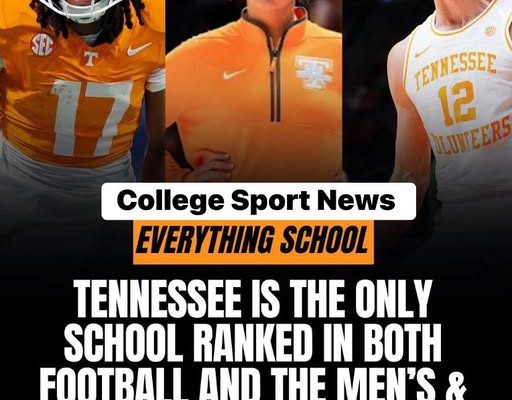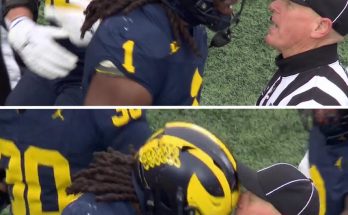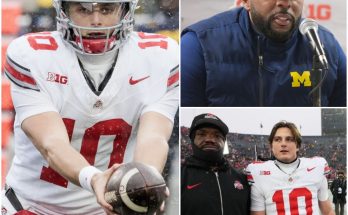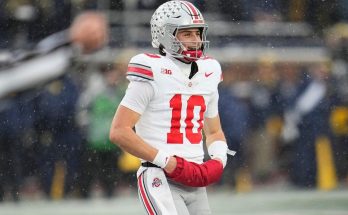College football fans were sent into a frenzy this morning as news broke that Bubba Hampton, one of the most dynamic and versatile players in recent years, has officially entered the NCAA transfer portal. This development marks a significant shift not only for Hampton’s career trajectory but also for the college football landscape as a whole, igniting speculation, excitement, and debate among fans, analysts, and recruiters nationwide. The transfer portal has become the epicenter of college football movement, offering athletes unprecedented freedom to explore opportunities and elevate their careers, and Bubba Hampton’s decision exemplifies the growing trend of elite players leveraging this system to find the best fit for their talents and ambitions.
Hampton, widely regarded for his explosive speed, versatility, and playmaking ability, has been a standout since his early days on the field. His ability to impact a game both as a rusher and receiver has drawn attention from scouts, coaches, and sports media alike. While many fans have grown accustomed to seeing him light up stadiums with electrifying runs and clutch catches, today’s announcement shifts the narrative from his current team’s on-field performance to the uncertainty and opportunity that come with a transfer. The portal is a stage where legacies can be reshaped, and Hampton’s decision suggests he is ready to take control of his next chapter.
Entering the transfer portal is rarely a decision made lightly, especially for a player of Hampton’s caliber. It often signals a desire for a fresh start, a more significant role, or an environment better suited to one’s development and long-term goals. For Hampton, the move could be driven by a variety of factors, ranging from team dynamics and playing time to strategic career planning and aspirations for professional football. In today’s competitive NCAA landscape, athletes are increasingly strategic, recognizing that the right program can amplify their exposure, enhance their skill set, and position them for NFL consideration. Hampton’s entry into the portal aligns with this mindset, signaling a thoughtful, proactive approach to his future.
The implications of this move extend far beyond Hampton himself. For his current team, his departure represents both a challenge and an opportunity. Losing a player of Hampton’s talent inevitably leaves a gap in offensive strategy, game planning, and team leadership. Coaches will need to adapt, reassess their roster, and identify players capable of stepping up to fill the void. Simultaneously, his exit opens the door for younger athletes to emerge, proving themselves on the field and carving out their own roles. In college football, every shift in personnel can ripple across a program, influencing recruiting, team morale, and on-field performance. Hampton’s decision is a reminder of how fluid and dynamic the NCAA landscape has become, where talent movement can reshape entire seasons.
From a recruiting perspective, the news has sparked immediate interest from programs across the country. Hampton’s skill set makes him an attractive target for teams seeking explosive offensive talent. His versatility allows him to be deployed in multiple roles, whether as a primary ball carrier, a slot receiver, or even in gadget plays designed to exploit mismatches. Coaches will undoubtedly consider how Hampton could integrate into their offensive schemes, and how his presence might elevate their team’s competitiveness in a crowded, talent-rich conference landscape. Recruiting analysts have already begun speculating about the schools that could offer the perfect blend of opportunity, exposure, and developmental support for his next chapter.
The timing of Hampton’s entry into the portal is also noteworthy. With the college football season in full swing, the transfer landscape is especially dynamic. Programs are actively evaluating needs, assessing roster depth, and seeking players who can make an immediate impact. For Hampton, this timing presents both opportunities and challenges. On one hand, he has the chance to attract attention from programs ready to integrate him right away. On the other hand, the crowded transfer market means that competition is fierce, and decisions must be made carefully to ensure the best possible fit. Coaches and sports analysts will be monitoring his next move closely, weighing the potential impact on their respective programs while forecasting how his arrival could alter the competitive balance of college football.
Media coverage has been swift and extensive, reflecting Hampton’s high profile and the broader fascination with the transfer portal era. Social media platforms are buzzing with speculation, fan reactions, and analyses of potential destinations. Pundits are dissecting his previous performances, evaluating which offensive schemes would maximize his effectiveness, and debating which programs have the best combination of coaching, exposure, and championship potential. The transfer portal has become a media spectacle in its own right, turning player movements into breaking news events that dominate sports coverage, and Hampton’s decision is a prime example of this phenomenon.
Beyond the immediate tactical considerations, Hampton’s entry into the transfer portal is emblematic of a broader shift in college athletics culture. Players today are empowered in ways that previous generations were not, with greater agency over their careers and the freedom to seek environments aligned with their personal and professional goals. This trend has sparked discussions about the balance between loyalty, opportunity, and ambition. While some traditionalists lament the fluidity of rosters, others celebrate the empowerment of athletes to make choices that serve their development and long-term success. Hampton’s decision will likely fuel these conversations, serving as a case study in the evolving nature of college football.
Analysts examining Hampton’s career trajectory note that his versatility is among his most significant assets. He has consistently demonstrated the ability to make game-changing plays in high-pressure situations. Whether breaking tackles, finding seams in defensive coverage, or executing precise routes, his skill set is well-suited to modern, fast-paced offensive systems. Teams that value a dynamic, multi-dimensional threat will undoubtedly consider Hampton a coveted acquisition. His capacity to adapt to different offensive philosophies makes him a unique commodity in the transfer portal, where programs seek players who can quickly assimilate and contribute immediately.
For fans, the announcement evokes a mixture of excitement, anxiety, and anticipation. Supporters of his current program are grappling with the prospect of losing a key playmaker, while fans of potential destination schools are envisioning how Hampton could transform their team’s offensive output. In today’s interconnected media environment, fan reactions spread rapidly, shaping narratives and even influencing recruiting dynamics. Social media conversations, online forums, and fan podcasts have already erupted with speculation, demonstrating the cultural significance of player movement in college sports. Hampton’s transfer journey will likely dominate headlines for weeks as fans, analysts, and coaches follow every development.
Hampton himself has yet to publicly announce his preferred destination, leaving the field wide open for speculation. Players in the portal often weigh multiple factors, including coaching relationships, offensive philosophy, team culture, geographic preference, and academic fit. The decision-making process can be intense, requiring careful consideration to ensure alignment with long-term career goals. Hampton’s talent gives him leverage in this process, allowing him to evaluate multiple programs that can provide both immediate playing time and a platform to showcase his abilities to professional scouts. The suspense surrounding his next move adds an extra layer of intrigue to an already electrifying development.
It is also important to contextualize Hampton’s move within the broader trend of NCAA transfers. The portal has transformed college football, creating a highly competitive ecosystem where talent flows freely between programs. The result is a dynamic, ever-changing landscape where success often depends not just on recruiting high school talent but also on strategically acquiring experienced college players. Hampton’s entry into the portal reinforces this trend, underscoring the growing significance of player mobility in shaping team performance and conference competitiveness. For coaches, effectively navigating the transfer portal has become as critical as traditional recruiting, requiring agility, foresight, and relationship-building.
As this story develops, one of the key questions will be the impact on Hampton’s legacy. Transfers can be pivotal moments in a player’s career, offering opportunities to redefine themselves, reach new heights, and make indelible marks on multiple programs. Hampton has already demonstrated the talent and work ethic to succeed at a high level, and the right program could elevate him further, positioning him for awards, accolades, and potentially a future in the NFL. Conversely, the transfer also carries risks; adaptation challenges, system mismatches, or unforeseen circumstances could complicate the transition. The stakes are high, and Hampton’s next choice will be closely scrutinized by all corners of the football world.



